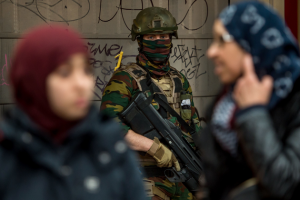The large terror cell that conducted both the November 2015 attacks in Paris (http://soufangroup.com/tsg-intelbrief-the-paris-attacks-and-a-continent-on-edge/) and the March 2016 attacks in Brussels (http://soufangroup.com/tsg-intelbrief-terror-strikes-brussels/) is finally being unraveled, though not before killing 162 people, wounding hundreds more, and exposing systemic flaws (http://soufangroup.com/tsg-intelbrief-europes-heightened-terror-concerns/) in parts of the EU’s approach to counterterrorism (http://soufangroup.com/tsg-intelbrief-resilience-and-the-terror-threat-in-europe/) . As horrific as the Brussels attacks were, reports indicate they could have been much worse. The March 18 arrest of Salah Abdeslam (http://soufangroup.com/tsg-intelbrief-the-capture-of-paris-attacker-salah-abdelslam/) —the only known living perpetrator of the Paris attacks—by Belgian authorities appears to have caused others in the cell to change plots and targets due to fear of imminent
arrest. The group reportedly had planned to attack locations in France associated with the Euro 2016 football championship—venues that would be packed with people. Security is always a concern at large-scale gatherings and even attacks on the periphery (http://soufangroup.com/tsg-intelbrief-the-soft-targets-of-terror/) of enhanced security zones can result in massive casualties.
The information about the Euro 2016 plot reportedly came from Mohammad Abrini, the now-captured ‘man in the white hat’ who fled the scene of the Brussels airport bombing. The Hollywood notion of master criminals impervious to standard, long-proven interrogation techniques has once again proven false and misleading, as both Abdeslam and Abrini have provided much-needed information. Abrini was captured in Brussels on April 8, as part of an intensive law enforcement sweep in the aftermath of the attacks. In counterterrorism, raids tend to lead to more raids until a tipping point is reached and the targeted group begins to unravel and then collapse. Time will show if the Brussels group has reached that tipping point.
The possible dismantling of the Brussels cell will not mean the end of the threat to Europe (http://soufangroup.com/tsg-intelbrief-the-scope-of-the-terror-threat-in-europe/) . Countries such as France and Belgium have seen large numbers of their citizens travel to Syria (http://soufangroup.com/foreign-fighters/) to join the so-called Islamic State (http://soufangroup.com/the-islamic-state/) . It does not take a large number (http://soufangroup.com/tsg-intelbrief-capabilities-over-numbers-for-islamic-state-operatives/) of relatively trained or hardened fighters to disrupt cities and regions; the continent will be dealing with the issue of returning foreign fighters (http://soufangroup.com/tsg-intelbrief-foreign-fighters-and-those-who-return/) for years. There are likely similar cells—hopefully smaller and less effective—in problematic neighborhoods across the EU, with no country immune to the merging of local criminals with a global ideology. Exacerbating counterterrorism
efforts is the gang-like nature of cells, where ties of friends and family (http://soufangroup.com/tsg-intelbrief-the-family-ties-of-terror/) create self-sustaining feedback loops of motivation and loyalty.
As seen with the reports of a plot against Euro 2016, high-profile events will be under greater threat than even the normally high-level baseline threat (http://soufangroup.com/tsg-intelbrief-when-terrorists-assault-cities/) . Likewise, mass transportation, however hardened, will continue to be a prime target. While the sheer number of potential targets is unknowable and unmanageable for security officials, the usual suspects of crime and terrorism are very knowable. Officials are rarely surprised at who is involved in these plots and attacks. Continuing to detect and then disrupt these groups—which are comprised mostly of individuals with criminal records (http://soufangroup.com/tsg-intelbrief-the-criminals-of-terror/) as well as social and family ties to a distinct geographical area—will need to become the new normal for the various law enforcement agencies across the EU.



